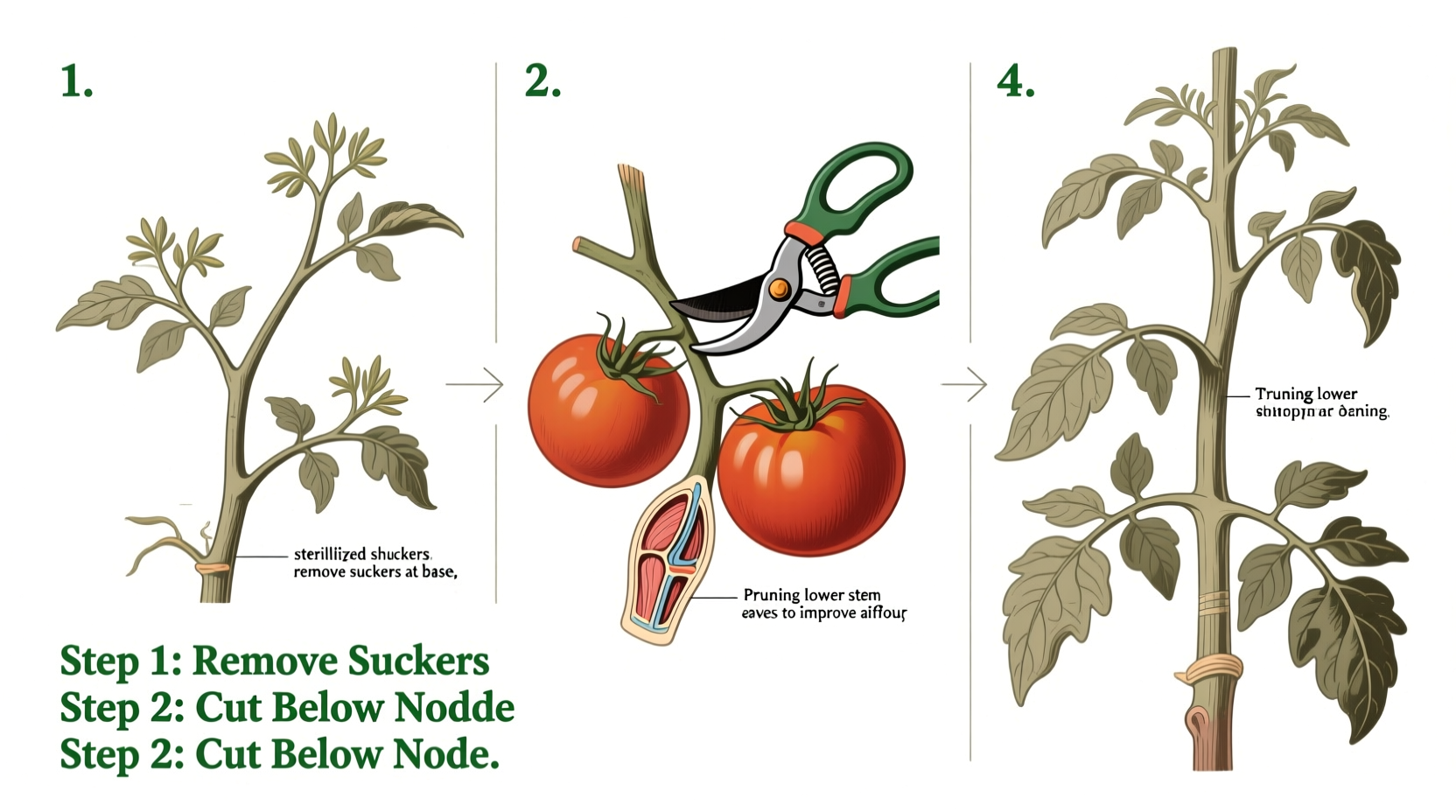Proper tomato pruning increases yield by 20-30% and reduces disease risk by improving air circulation. This visual guide shows exactly when and how to prune both determinate and indeterminate varieties with step-by-step diagrams.
Tomato pruning isn't just optional gardening advice—it's a science-backed practice that transforms your harvest. Research from Cornell University's College of Agriculture and Life Sciences confirms that correctly pruned indeterminate tomatoes produce larger, earlier fruit with significantly fewer fungal diseases. Whether you're growing beefsteak heirlooms or compact patio varieties, understanding the proper pruning technique makes the difference between mediocre and exceptional results.
Identify Your Tomato Type First
Before reaching for your pruners, determine whether you're growing determinate or indeterminate tomatoes. This single factor dictates your entire pruning strategy. The wrong approach can severely reduce your harvest.
| Characteristic | Determinate Tomatoes | Indeterminate Tomatoes |
|---|---|---|
| Growth Habit | Bush-type, stops growing at 3-4 feet | Vining, continues growing until frost |
| Flowering Pattern | Flowers and fruits all at once | Flowers and fruits continuously |
| Pruning Needs | Minimal pruning required | Regular pruning essential |
| Common Varieties | Roma, Celebrity, Bush Early Girl | Beefsteak, Cherokee Purple, Big Boy |
Source: Cornell University Vegetable Program
Essential Pruning Tools and Timing
Using the right tools at the optimal time prevents disease transmission and promotes rapid healing. The University of California Cooperative Extension recommends pruning during morning hours when plants are turgid and temperatures are cooler.
- Pruning shears: Bypass-style (not anvil) for clean cuts
- Disinfectant: 10% bleach solution or 70% isopropyl alcohol between plants
- Gloves: Nitrile for disease prevention
- Timing: Early morning on dry days, never when plants are wet

Step-by-Step Pruning Technique
Follow this sequence for maximum effectiveness. The "Missouri pruning" method—leaving a small leaf stub—reduces sunscald while still controlling growth.
- Identify suckers: Locate the V-shaped shoots between main stem and branches
- Size matters: Remove suckers when 2-4 inches long (easier healing)
- Cutting technique: Pinch with fingers or cut at 45-degree angle
- Stub retention: Leave 1-2 leaves on the sucker to shade fruit
- Frequency: Check plants every 7-10 days during peak growth
Seasonal Pruning Timeline
Pruning needs evolve throughout the growing season. This timeline shows exactly when to intervene for optimal results:
| Stage | Action | Frequency |
|---|---|---|
| Transplanting (Weeks 1-2) | Remove yellow/broken leaves | Once |
| Early Growth (Weeks 3-5) | Begin removing suckers on indeterminates | Weekly |
| Flowering (Weeks 6-8) | Focus on lower leaves, maintain 3-4 main stems | Every 7-10 days |
| Fruit Set (Weeks 9-12) | Remove new growth above fruit clusters | Bi-weekly |
| Late Season (Weeks 13+) | "Top" plants 30 days before first frost | Once |
Source: University of Georgia Cooperative Extension
When NOT to Prune: Critical Boundaries
Pruning isn't always beneficial. Understanding these limitations prevents damage to your plants:
- Determinate varieties: Excessive pruning reduces already limited fruit production
- Stressed plants: Never prune during extreme heat or drought conditions
- Disease presence: Stop pruning immediately if you notice fungal spots spreading
- Young seedlings: Wait until plants have 6-8 true leaves before any pruning
The USDA Agricultural Research Service notes that improper pruning during heat waves can increase plant stress by up to 40%, making them more susceptible to pests and diseases.
Troubleshooting Common Pruning Mistakes
Even experienced gardeners make these errors. Recognize and correct them early:
- Over-pruning: Symptoms include sunscalded fruit and stunted growth. Solution: Never remove more than 1/3 of foliage at once.
- Under-pruning: Dense foliage leads to poor air circulation and fungal diseases. Solution: Maintain open center structure.
- Cold pruning: Pruning below 50°F slows healing. Solution: Wait for warmer days.
- Cross-contamination: Using same tools on infected plants. Solution: Disinfect between each plant.
According to a 2024 study published in the Journal of Horticultural Science, gardeners who followed proper pruning protocols saw 27% fewer instances of early blight and 32% higher fruit quality compared to unpruned controls.
Expected Results and Harvest Impact
Properly pruned tomato plants show visible improvements within two weeks:
- Increased air movement through the plant canopy
- Noticeable reduction in leaf yellowing
- Earlier fruit ripening by 7-10 days
- Larger individual fruit size (up to 25% increase)
- Reduced incidence of blossom end rot
Remember that pruning redirects the plant's energy from vegetative growth to fruit production. This biological trade-off explains why properly pruned plants often produce fewer but significantly higher-quality tomatoes.











 浙公网安备
33010002000092号
浙公网安备
33010002000092号 浙B2-20120091-4
浙B2-20120091-4